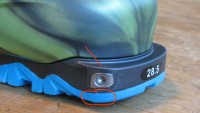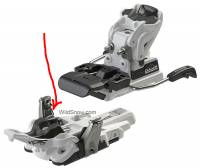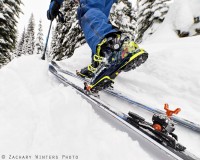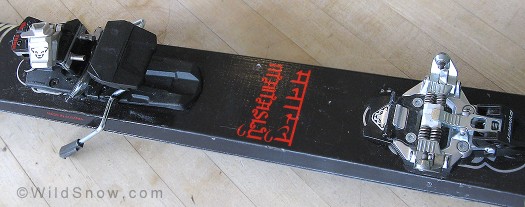No snow yet? Do some shopping for this year’s clothing over at Backcountry.com.
1. Here at WildSnow.com we define “tech” binding as any ski binding that uses special steel boot TOE socket fittings invented by Fritz Barthel and popularized by Dynafit. Most of the Barthel binding patents expired some time ago, thus allowing the tech binding and associate boot toe fittings to become a de facto standard that’s “copied” by numerous makers.
2. Most tech bindings use special steel boot heel fittings as well, with the exception of Marker Kingpin. (A broader category is “frameless” bindings, simply meaning the heel and toe units are not connected by a plate, but could use any type of boot fittings. Trab TR2 binding is a good example of a frameless binding that we would not call a “tech” binding as it uses proprietary boot fittings at both toe and heel.)

The usual boot toe tech fittings for Dynafit and other types of tech bindings. Click images to enlarge.
3. Unlike alpine bindings that are quite forgiving as to the shape of the boot sole, tech bindings are dependent on the quality and tight tolerances of the steel boot fittings on the boot toe and heel. There is no official industry standard for the exact shape of the boot fittings, though the sizing and metallurgy of the Dynafit brand fittings is a de facto standard. Apparently, the ISO ski touring boot standard 9523 is under revision for the location of the boot fittings in relation to the rest of the boot, but does not appear to address the manufacturing standards for the actual fittings other than in brief terms. The ideal fittings are quite sophisticated, with a varied radius of the toe sockets that resists pre-release in touring mode (heel somewhat elevated) but smooths out release when the boot is in the flatter alpine position. Most current fittings have been dumbed down, without the varied radius. Sad, but they still work if the user is diligent about locking the toe for touring mode.
As far as we know, Dynafit provides their fittings to two other boot makers, Scarpa and Fisher. The Dynafit fittings are indicated by a red plastic “seal” clip that’s attached to the new boot. All other boot makers have their own fittings manufactured by various third parties. In our experience ALL boot fittings, including Dynafit, must be immediately tested for proper release function by an experienced do-it-yourselfer or ski shop technician. The boot should release to the side at the heel smoothly (if the binding releases at the heel) without catching at the toe sockets during the second stage of the release movement. There should be no rattle or slop, no clicking while striding in touring mode, and (with reasonable uphill technique) no problems with coming out of the binding while locked in touring mode.
4. Beware of blaming tech binding problems on the binding, when they’re actually caused by the boot fittings. Test interface problems such as play and sticky release by substituting several other pairs of boots, of various brands. If the problem goes away, it is probably the boot!

Fritschi Vipec opens to the side at the toe for lateral (twisting) safety release; most tech bindings instigate lateral release with heel rotation while the boot simultaneously comes out of the binding toe.
5. Know that all tech bindings that side release at the heel actually have a “two stage” release. This means the heel of the boot moves to the side, then the toe wings open or do a combination of rotating and opening. Fritschi Vipec is the notable exception to this; it opens to the side at the toe as the first and only stage of lateral release (and is similar to most alpine bindings in this regard). It remains to be seen which (if any) of these ways of releasing are safer than others. Companies are making claims, but we’ve seen no studies or data based on real world use.
6. There has never been a major brand tech binding design family, of any brand, that did not have subsequently corrected problems in the first retail versions. In the opinion of certain informed insider sources, it is a miracle some of these episodes have not come under the purview of certain government entities that shall remain nameless herein.
7. Tech bindings were originally designed for ski touring and ski mountaineering using narrow skis and soft ski mountaineering boots of the 1980s. Repurposing the design as a freeride binding is problematic. We feel a “tech 2.0” complete redesign of the system — including boot fittings — is the solution. But standards, even unofficial ones, die hard. The engineering being done to force freeride performance from the tech system is amazing. It’s like making a Formula 1 racer from a Volkswagen — on a limited budget. See our ski touring binding museum.
8. It is an open question if ANY tech binding matches the safety (injury protection) of recent and top quality alpine bindings paired with alpine boots. In our opinion, most tech bindings do NOT match the safety of a properly adjusted alpine setup. That being said, expert skiers commonly adjust their binding release values to excessively high settings, thus obviating any meaningful comparison of safety between binding types and models.

G3 ION is a good example of a beefy high quality tech binding that, while not certified to DIN 13992, appears to offer excellent performance and beef.
9. Few tech bindings are overall appropriate for more than occasional resort skiing for two reasons: excessive wear on the binding, as well as safety release and shock absorption that’s in some cases not as good as alpine bindings. Possible exceptions are the DIN/ISO 13992 certified offerings such as Marker Kingpin and Dynafit Beast, as well as certain non certified tech bindings that are obviously beefed and marketed for hard use. A good example is Fritschi Vipec. In any case, know that while the DIN/ISO 13992 standard for backcountry skiing bindings is NOT an alpine binding standard, it is quite similar and does give you some idea of a binding’s level of sophistication. That said, the ISO ski binding standards are not as modern nor as rigorous as one would assume. Do not regard them as the end-all be-all in criteria for picking a good binding. ISO 13992 standard explained.
10. Some Europeans call tech bindings “lowtech,” “pin” bindings or “pintech” bindings. We sometimes use the term “pintech” but shy from the term “pin” because that’s traditionally used for telemark bindings. For more terminology please check out our ski touring glossary.
For more information, please see our Dynafit and tech binding FAQ, as well as search results on our 3,000+ blog posts.
WildSnow.com publisher emeritus and founder Lou (Louis Dawson) has a 50+ years career in climbing, backcountry skiing and ski mountaineering. He was the first person in history to ski down all 54 Colorado 14,000-foot peaks, has authored numerous books about about backcountry skiing, and has skied from the summit of Denali in Alaska, North America’s highest mountain.


